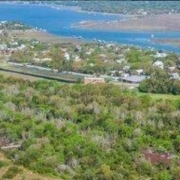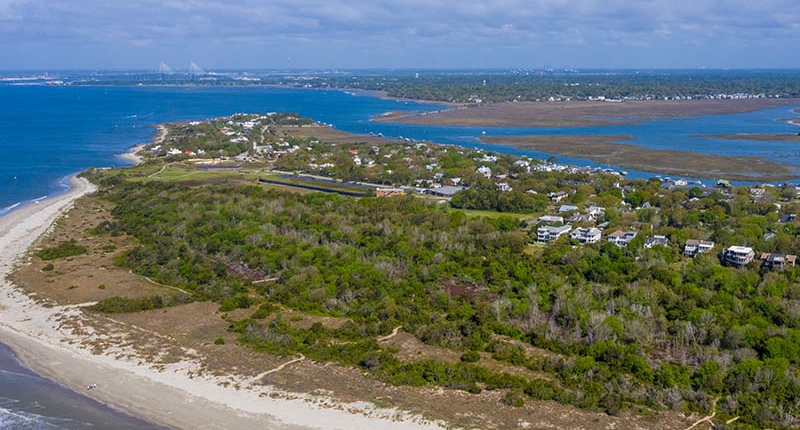Maritime Forest Serves as Habitat and Protector
This letter to the editor written in 2021, has stood the test of time and we wanted to re-share this with you!
(Letter to the Editor Written by Grace Reed)
Sullivan’s Island does not exist in a vacuum. The importance of Sullivan’s Island’s Maritime Forest is closely related to the neighboring communities of Mount Pleasant and Charleston.
The islands along the coast of South Carolina are called “barrier islands” for a reason. They act as a barrier between the enormous forces of the Atlantic Ocean and the mainland. Were it not for the barrier islands, there would be waves crashing onto the Battery in Charleston and the Intracoastal side of Mount Pleasant. One has only to look at an aerial photo of Sullivan’s Island to realize its vital position as a massive surf break for Mount Pleasant during hurricanes.
A high density of trees and vegetation on the island serves to fortify its diffusive effect on the velocity of ocean waves during a storm surge. Thus the trees and shrubs of the Maritime Forest on Sullivan’s Island’s accreted land play an important role in the protection of Mount Pleasant and downtown Charleston, in addition to the protecting the middle and back side of the island itself.
Besides protecting the mainland, the trees and shrubs of the Maritime Forest act as a critical habitat for migratory and indigenous songbirds and butterflies. Moreover, the flora and fauna of the Maritime Forest are woven in a complex web of co-dependence to create a thriving ecosystem.
As an example, the lowly wax myrtle provides a necessary food source for tree swallows which migrate in masses of thousands and swoop through the myrtles to snatch berries on the fly. The berries of the myrtle also are a necessary food source for the beautiful myrtle warbler, which overwinters here. These birds, in turn, help to propagate the myrtles by spreading seeds in their droppings. Cutting myrtles to 3-feet or 5-feet, as designated in the Sullivan’s Island mediation agreement, could deprive the tiny warbler of protective cover, and also affect the availability and accessibility of berries. The lack of an abundant source of food could threaten individuals of both these species during their most vulnerable seasons.
Most people are aware of the habitat needs of the Monarch butterfly, which stops on Sullivan’s Island during its southern migration in fall. But they might not realize the importance of the Hackberry tree for our indigenous Hackberry butterfly. Hackberry nectar and sap are important food sources for the butterfly. Also, it lays its eggs exclusively on that species and the larva hatch to feast on the leaves of the Hackberry before pupating. The larva and butterflies, in turn, provide food for many migrating songbirds. Yet in the Sullivan’s Island mediation agreement, the Hackberry tree is considered expendable and allowed to be removed.
During the last 25 years, there has been a vitally important occurrence in Mount Pleasant that has largely gone unrecognized. For countless eons, one of the the southward neotropical song-bird migrations has generally followed the Eastern coastline. One of the reliable and important stopovers on their journey has been Patriots Point, where the birds have dropped down for rest, food and water before crossing the “big water” of Charleston Harbor. However, the state-sanctioned development of Patriots Point has resulted in a significant loss of valuable habitat. When the millions of migrating birds and butterflies arrive here, each year there is less land and vegetation to support them.
However, as that door has shut, a window has opened in the growth of an alternative habitat on Sullivan’s Island, just a few miles away.
The importance of Sullivan’s Island’s Maritime Forest is interwoven with the area around it, both as habitat and in storm surge mitigation. Its protection should be considered vital for Islanders and mainlanders alike.
STAY IN TOUCH!
Sullivan’s Island For All
1985 Riviera Drive, Suite 103
Box 201
Mount Pleasant, SC 29464
FOLLOW US:
©Sullivans Island for All 2021
This is a notification that can be used for cookie consent or other important news. It also got a modal window now! Click "learn more" to see it!
OKLearn MoreCookie and Privacy Settings
We may request cookies to be set on your device. We use cookies to let us know when you visit our websites, how you interact with us, to enrich your user experience, and to customize your relationship with our website.
Click on the different category headings to find out more. You can also change some of your preferences. Note that blocking some types of cookies may impact your experience on our websites and the services we are able to offer.
These cookies are strictly necessary to provide you with services available through our website and to use some of its features.
Because these cookies are strictly necessary to deliver the website, you cannot refuse them without impacting how our site functions. You can block or delete them by changing your browser settings and force blocking all cookies on this website.
We also use different external services like Google Webfonts, Google Maps and external Video providers. Since these providers may collect personal data like your IP address we allow you to block them here. Please be aware that this might heavily reduce the functionality and appearance of our site. Changes will take effect once you reload the page.
Google Webfont Settings:
Google Map Settings:
Vimeo and Youtube video embeds:
You can read about our cookies and privacy settings in detail on our Privacy Policy Page.
Privacy Policy

